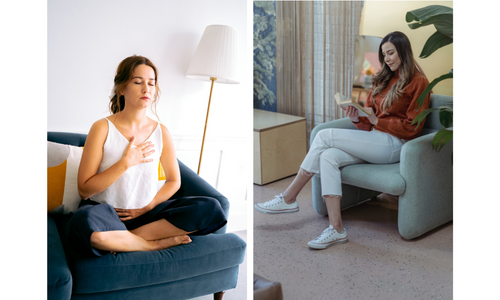Counteract Cravings By Creating Places That Cue Calming

Issue No. 12 | Brought to you by the Addiction Reset Community – ARC
Unlocking the secrets of processed food addiction and guiding you to find freedom from food and weight obsession.

Research shows that the brain can be conditioned to react to processed food cues by producing craving neurotransmitters such as dopamine, opiate, serotonin, endorphins, and endocannabinoids. The flood of these neurotransmitters has been shown to coincide with the suppression of the key ‘thinking’ functions necessary to resist cravings such as decision-making, memory, and restraint. This combination of intense cravings coupled with loss of rational thought may be considered as a primary dysfunction driving addiction to processed foods.

The kinds of cues which trigger addictive brain responses include sights, sounds, smells, availability, stress, fatigue, relationships, and intense positive or negative emotions. These cues can become associated with the place in which they occur. Place cues are powerful.
Cued-food cravings have been shown to be a leading cause of relapse into overeating. Cued-calming uses a similar conditioning process to teach the brain to stop craving and restore rational decision-making and restraint.
A compounded cued-calming place for stopping cravings can be used to desensitize reactions to a craving place, recover from triggered cravings, and reduce risks associated with going to a highly-cued food place.

The development of compounded cued places for calming the brain has three phases:
- Set up multiple calming cues in a particular place.
- Expose the brain repeatedly to calming practices in that place to condition the brain to associate calming with that place.
- Go to the cued-calming place at times of cravings triggers. We can go to the place physically or through visualization.
Select Calming Places
- Pick out three to four places where you spend the most time. Common places might be kitchen, bedroom, car, and work/volunteer place.
- Then pick out activities that are most calming to you. These might include reading, meditation tape, soothing music, yoga, an exercise video, affirmations, an art/craft project, pleasant pictures, breathing, prayer, dancing, or listening to a meeting tape. Do not watch television in these places because television is a source of anxiety.
- You can associate these calming activities with a piece of jewelry you wear often, a pleasant smell, or even a motion such a tugging on your ear.
- Use these calming activities repeatedly in your chosen places. Use as many different techniques as possible to create compounded calming cues.
- Also, condition your brain to expect and experience non-addictive foods in these places. You might take pictures of clean meals and keep them in a folder in these places, or you might even eat clean meals in the place. While looking at the pictures or eating, you can repeat affirmations such as, ‘This is my food. This food keeps me safe. I am safe with this food.’

Desensitization
- You can desensitize your brain to places associated with past use of addictive processed foods. This would be especially useful for rooms in your home such as kitchen, dining room, and bedroom. This would also be applicable for rooms where you’ve watched television because television conditions the brain to crave.
- Just sit in that room and use calming techniques repeatedly and for prolonged periods of time. Not only will you disassociate cravings from that place, but you will also replace craving cues with calming cues.

Risk management
You can also use this technique if you are going to a high-risk place such as a meeting room, relative’s home, or restaurant. Although you may not be able to go physically to the new place, you can imagine yourself using your calming techniques in that place. By repeatedly using different calming techniques while visualizing the high-risk place, you are conditioning your brain to associate calming with that place. When you go to that place, your brain will be conditioned to go into a calm, stable state.
Trigger management
If you are triggered, you can visualize yourself in one of the places where you have conditioned your brain to react with calm. Or, you can physically go to that place to cue your brain into a calm state.
Food addiction can be a tough disease to put into remission. And it can be tough to maintain the disease in remission. However, by practicing and maintaining brain-calming conditioning and by protecting your brain from reactions to cues, you are decreasing the chances of relapse. And, you may find that having a calm brain is a pleasurable way to live life.

Within the Addiction Reset Community (ARC) our members and their journeys are important to us. We find their stories inspiring and hopeful for everybody in health recovery.
“I’ve had a weekend of self-care because I haven’t been feeling well. While admitting I needed the time out I also knew I needed to keep connected with the ARC. When we’re most vulnerable, our addictive voice can try to creep in and I wasn’t taking any chances with that. The ARC helps my mind stay connected to my evolving self. It reminds me why choosing me and eating clean is always the best decision for me.”

Many people reach out to Joan asking for advice and assistance on how they can begin their recovery journey.
Dear Joan
There are times in the past were I have managed to push through the cravings & eat healthy for 3-4 weeks. I can feel my mental & physical health improve massively. Then the cravings return and I feel helpless against them. What causes the cravings and how can I stop them?
Joan responds:
Processed foods cause a release of 'feel-good' brain chemicals. The release is a surge followed by a crash. In the crash, we feel terrible without enough 'feel-good' neurotransmitters in our brain. The brain puts intense urges, longing, and cravings in our thoughts to get us to eat processed foods again and stimulate the release of more 'feel-good' neurotransmitters. Unfortunately, this just leads to more cravings.
The good news is that your brain can be retrained NOT to crave. This requires an effective process of immersion in recovery messaging while learning techniques and skills to manage triggers and cues, to overcome cravings and to avoid relapse on processed foods.
Research shows that processed foods are associated with mood swings. Processed foods are absorbed very quickly into the blood stream causing glucose levels to rise quickly. This can make the addicted person feel high and even euphoric. However, the pancreas responds to bring down glucose levels by releasing insulin. Insulin can bring down sugar levels very quickly which feels like a crash. People can become very depressed and angry in the sudden drop. With the right support based on the new science of food addiction management, you can regain control of your food and eliminate the mood swings.
DISCLAIMER:
Dr Joan Ifland (PhD) is a global expert on the subject of processed food addiction and is not a medical doctor. Information and response shared in this Newsletter are not intended for, and should not be construed as medical advice.

Do you have a question? Reach out to us with your questions about food addiction and recovery at gethelp@foodaddictionreset.com
Are you showing signs of Processed Food Addiction? Take this self-quiz to find out now!
Recent copies of Dr Joan Ifland's Blog:
Issue 01 | Issue 02 | Issue 03 | Issue 04 | Issue 05 | Issue 06 | Issue 07 | Issue 08 | Issue 09 | Issue 10 | Issue 11

